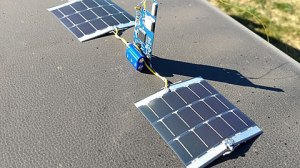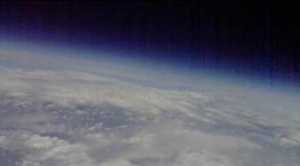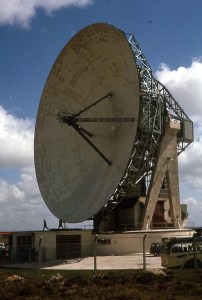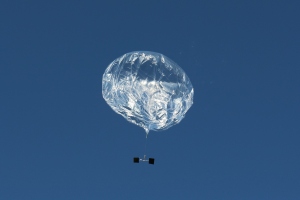
UBSED24 flight path May 8, 2017
Richard Meadows M0SBU reports there will be a second attempt to launch the Raspberry Pi Zero equipped 434 MHz balloon UBSEDS24 early Monday morning.
Update: At 1700 GMT May 8 the team reported “Our Raspberry Pi Zero balloon #UBSEDS24 is over France”.
On the UKHAS Google Group Richard writes:
There’s going to be another attempt to launch this flight from Bristol this Monday, May 8 between 0500 and 0530 BST [0400-0430 GMT]. This is weather permitting, but the forecast looks okay at the moment.
This launch is using a 1.9m envelope and longer payload train, and so there’s a NOTAM in place. This tracker has a Raspberry Pi Zero V1.3 attached, which transmits images when solar power is available. It’s a different design to our launch last August; in this case the tracker will continue to operate even if the pi fails. For the curious the ‘pi status’ telemetry values are: 0 = off, 1 = on, 2 = PITS started, 3 = SSDV started).

SSDV picture taken by from UBSEDS24 on May 8, 2017
There will hopefully be a cutdown mounted between the balloon and the tracker. We’ll be testing the 434 MHz uplink to this whilst it’s still in range of Bristol; if it returns over the UK at a convenient time and place we will attempt to trigger the cutdown.
The tracker has several transmissions:
– 434.635 MHz USB Telemetry – Contestia 16/1000 with pips and RSID, transmitting telemetry. Once per minute below 8km altitude and every two minutes otherwise.
– 434.637.5 MHz SSDV – Two modes:
(1) While balloon over UK and English channel GMSK at 12 ksymbol/s. 4×4 interleaved, R=1/2 convolutional K=5, HDLC framing, whitened etc. as per the AX5043 manual. Concatenated with RS(255,223) to mop up some burst errors.
(2) Outside UK 300 baud RTTY, 850 Hz shift, 8N2.
If you are listening to the RTTY, remember to turn off the ‘RxID’ button on the top right of dl-fldigi.
Rather than the usual JPEG SSDV, this is transmitting Better Portable Graphics (BPG) images. This is experimental, and ssdv.habhub.org doesn’t support it just yet. Hence receivers should upload to http://ssdv.bristol-seds.co.uk instead, please read the instructions on this site. You’ll need dl-fldigi release 3.2, as explained on the site. James Coxon M6JCX has made the dl-fldigi release available at: https://github.com/jamescoxon/dl-fldigi/releases/tag/3.2
The flight is expected to head south towards France. Many thanks to everyone who attempts to track this.
Track the balloon online at https://tracker.habhub.org/
Listen to the balloon online with the SUWS WebSDR link at https://amsat-uk.org/beginners/balloons/
UBSEDS https://twitter.com/bristolseds
http://www.bristol-seds.co.uk/hab/flight/2017/05/08/ubseds24.html
Richard M0SBU who is involved in the UBSEDS project took the amateur radio training courses run by the Chelmsford Amateur Radio Society (CARS) at Danbury in Essex. Further information on the courses is available from the CARS Training Coordinator, Christopher G0IPU
Tel: 07908-107951
Email: training2017 at g0mwt.org.uk
Web: http://g0mwt.org.uk/training
What is Amateur Radio? http://www.essexham.co.uk/what-is-amateur-radio
Find an amateur radio training course near you https://thersgb.org/services/coursefinder/







You must be logged in to post a comment.